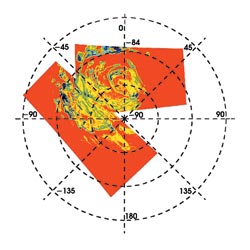Hank Hogan, Contributing Editor
The latest word on martian water and the possibility of life on the Red Planet comes courtesy of Observatoire pour la Minéralogie, l’Eau, les Glaces et l’Activité, or Omega, a visible and infrared mapping spectrometer aboard the European Space Agency’s Mars Express orbiter. Mars, as confirmed by results from Omega, has been cold and dry for billions of years.
“The implications for life are that any record of its presence on the surface would likely be in the ancient rocks and that if life were present today, it would have to be well underground,” said John F. Mustard, an associate professor of geological sciences at Brown University in Providence, R.I.
Mustard, along with principal investigators Yves Langevin and Jean-Pierre Bibring of France’s Institut d’Astrophysique Spatiale in Orsay, reported some of the first results from the instrument in the Feb. 17 edition of Sciencexpress. They found that large patches of the surface of the planet are not hydrated but that water seems to have carved out some of its features. This reshaping has taken place without leaving any mineralogical traces, except in some areas that are more than 3.2 billion years old.
The mapping spectrometer consists of two sensors, one for visible and near-infrared wavelengths from 380 nm to 1.05 μm and another for the near- and mid-IR from 930 nm to 5.1 μm. The instrument acquires spectra in 352 contiguous channels. The spectral size of a channel depends on the wavelength range, with a low of 7 nm below 1.0 μm to a high of 20 nm above 2.5 μm.
In the VIS/NIR channel, optics focus the image of a slit onto a concave holographic grating mirror, and the light falls on a frame-transfer CCD from Thomson Corp. (now Atmel Corp) Each row of the CCD contains an image of the slit at a given wavelength, and each column contains the spectrum of a point along the slit. Beyond 1 μm, Omega uses a scanning system composed of two linear arrays of InSb photodiodes as sensors. The arrays capture the spectrum for a single pixel, which then is scanned along the slit to get the complete picture.

The Omega VIS/IR mapping spectrometer on the Mars Express orbiter is finding that the Red Planet has been cold and dry for billions of years, suggesting that any fossil record of past life would be found in ancient deposits and that present life would have to exist underground. In this map of the martian south pole, blue indicates areas with water ice. Courtesy of the European Space Agency.
The data from Omega have put the results from Opportunity, one of the twin robotic geologists from NASA’s Mars Exploration Rover mission, into a larger context. By imaging locations near Opportunity and comparing the information with that from other areas, the investigators extended local surface observations over larger regional and global areas.
Work based on observations with Omega continues. The astronomers expect to uncover more details about Mars as they map during more seasons and over a greater part of the planet. There are plans to launch another instrument, the Compact Reconnaissance Imaging Spectrom?eter for Mars, this summer. It will cover a similar wavelength range as Omega but will feature more spectral bands and an order of magnitude greater spatial resolution. Researchers will use the new device to follow up on Omega’s findings and for other investigations.
Mustard noted that, although the evidence for present-day water and life on Mars is not good, all hope is not lost yet. “The nature of the ancient hydrated silicate and sulfate deposits offer many promising environments for future exploration.”